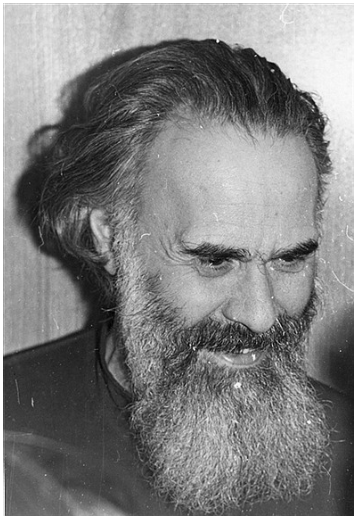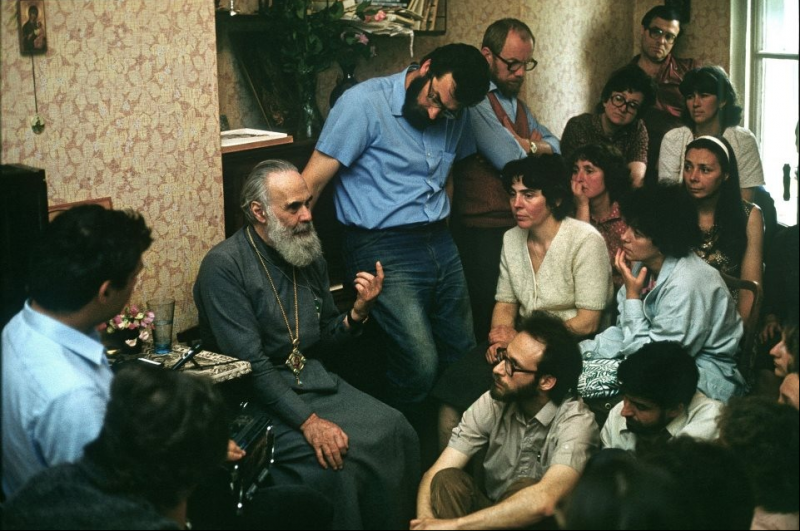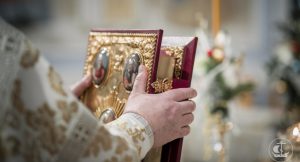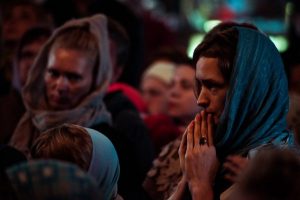 The following is a transcript of a lecture, unrevised by the author, given to Finnish Orthodox priests in Kuopio in August 1974.
The following is a transcript of a lecture, unrevised by the author, given to Finnish Orthodox priests in Kuopio in August 1974.
When speaking of the spiritual and the psychological realm, many people confuse these two regions. When you ask them about their spiritual life, they very often describe their psychological state, as though the whole spiritual life were made of physical and psychological expressions. When we read Holy Scripture, we see two realms clearly defined, from the beginning of the history of mankind: the spirit and body. Between these two there is a realm which is the human psyche, the human soul, which is very much like the twilight between darkness and light. It is the most difficult part of the human person to understand and interpret in terms of the spiritual life. The great difficulty in speaking of the psychological, the spiritual, and the physical realms is that we have a very definite experience of what happens in our body, and in our mind and emotions, but the realm of the spirit is known only to the few. You will remember a passage in St. Paul, saying that the spiritual man understands all things, judges all things, but that no one can judge him. There are short moments when we have a direct experience of the spiritual, but most of the time it is like the light of a lightning in a dark night. We perceive our body and our soul as something normal and habitual. Everything taking place in the realm of the spirit, which is the place where man meets both with God and Satan, has a repercussion in our physical and psychological world.
The ascetics consider that the realm of the body is a much safer way of understanding what happens in the spirit than the realm of the soul. A spiritual experience reaches our body, and as the divinity of Christ fills the body of His Incarnation, so the grace of God transforms our bodies. That explains why, in the lives of saints, when the writer wishes to make us understand how fully a man was rooted in God and lived by the grace of God, he describes his great ascetical feats. We see that the saints fasted beyond imagination, they kept incredible vigils, and they compelled their bodies to do what is totally impossible for us. The point of this description is not to impress us by what they could do physically: it is a way of showing indirectly that they were so completely alive in God that they needed almost nothing from the earth. But the ascetics warn us against the danger of the psychological realm. The psychological realm is that of imagination, of fantasy, of wrong interpretations; therefore it is the very realm that must be purified and conquered by God, by sobriety, and by a continuous struggle against imagination. And yet we must live with the soul, with the psyche which we possess, and we cannot be aware of God, of grace, otherwise than on that level. There is a point at which our psychological life can be destroyed by illness. And then a question comes to so many people: is it possible to have a disturbed mind and a real spiritual life?
Fr. John of Kronstadt says in his diary that when God sees a soul too frail for the brutality of the world, He allows a curtain to fall between the soul and the world. This curtain we call “mental illness.” And behind this curtain, between God and the living soul of man, a dialogue continues. I do not think that this is an explanation of all situations. But I have been profoundly impressed many years ago by an example to prove it.
We had in France a young man, an extremely talented artist, who gradually began to lose his mind. He had hallucinations, his inner world began to be fantastic, and one thing troubled greatly his friends and his family: he had been a very devout believer, and in his new mental condition he began to blaspheme God. Opinions were divided about him. The more devout people and part of the clergy thought that the solution was exorcism, anointing, and communion. I, without being a complete unbeliever, thought that he should be treated medically. And when all religious means had been tried on him without success, he was taken to hospital. He spent several years the in a complete state of mental trouble. The content of his mental illness was irreligious or full of blasphemy and his friends were afraid for his eternal life. When he recovered after a while, we discovered that he possessed not only the deep faith he had before his illness, but that he had acquired a spiritual maturity which he did not possess before. It was really as though, behind this curtain of mental illness, he had continued to be with God. Perhaps one could understand his blasphemy, and the irreligious or anti-religious type of his illness, by realising that all us have to undergo a very intense and, at times, a very violent struggle between good and evil. But when we are under normal mental conditions, we can control the struggle, and people do not know how deeply we may be inwardly distressed. But when, under the pressure of this mental struggle, the resistance, the mental resistance of a man, breaks down, the struggle may appear before the eyes of all people. And what in most people happens in the very depth of the secret part of their soul is suddenly exposed before the eyes of people. But as within us good and evil struggle, and in spite of the evil, we continue to have a deep dialogue with God. Side by side with this horrible expression of godlessness there may be very deep relationship with God.
 Leaving this example aside, I should like to tell you that in the Orthodox Church we have a class of saints called “Fools for Christ’s sake.” If you make a study of each individual life of these men and women, who from the point of view of the world were mad, you discover that they fall into two different categories. Some of them were men and women of outstanding intelligence, yet who for one reason or another wanted to appear to others as though they were mad. Hidden behind and protected by the madness, they could have a profound secret life with God, a life into which no one could penetrate or intrude because of the screen of madness, and a life of the spirit protected against the assaults of devilish pride by the continuous humiliation by men to which they were submitted.
Leaving this example aside, I should like to tell you that in the Orthodox Church we have a class of saints called “Fools for Christ’s sake.” If you make a study of each individual life of these men and women, who from the point of view of the world were mad, you discover that they fall into two different categories. Some of them were men and women of outstanding intelligence, yet who for one reason or another wanted to appear to others as though they were mad. Hidden behind and protected by the madness, they could have a profound secret life with God, a life into which no one could penetrate or intrude because of the screen of madness, and a life of the spirit protected against the assaults of devilish pride by the continuous humiliation by men to which they were submitted.
Among them, one or two chose to be mad as an act of charity. In the eighteenth century there lived, in Russia, a man who was profoundly distressed by the miserable condition of mad people in mental homes. In those days one did not know how to treat or to cure mental illness: mental, cases were taken to hospitals that were like prisons. They were chained to the wall and they were treated like animals. It is only in the nineteenth century that a great French psychiatrist gave freedom to mad people. There is a very moving statue in one of the hospitals of Paris where this man stands surrounded by mad people freed from their chains and kissing his hands and his garment in gratitude. The man of whom I have spoken, the “fool for Christ’s sake,” decided to become a presence of divine love and prayer in a mental place. He behaved as if he were mad himself, until he was put into a mental place and chained to a wall with others. All day he behaved like a violent madman, and all night he prayed and spoke to the other people with whom he lived. And he continued that for forty years of his life.
There is another category of “fools for Christ’s sake,” who are people with mental illnesses or mental debility. But even this did not prevent them from loving God and knowing Him and choosing a way of humiliation to follow Christ in His kenosis on the way of His humiliation. And it is one of the most inspiring and consoling thoughts to know that even mental disturbance cannot separate us from the living God. A priest cannot be trained as a psychiatrist, but a priest should have enough interest in what happens to the people around him to have some knowledge of the way in which mental illness manifests itself. When a mental person happens to be also a believer, he projects his mental state on everything, also on his life in Church. It is very important for the priest to be able to say: this is illness, and this is a mystical experience.
I give you two examples for illustration: A person came to see one of our old priests in France, with a complete description of a spiritual state described as “darkness of the soul.” The person thought that she was one of the great mystics of the present day, and she was profoundly offended when the old, experienced priest said to her: “Go to a doctor, it is your liver!”
I remember another occasion when one of the Anglican convents sent me a young nun. She presented mental trouble that could not be cured by simple counsel. She had been sent to a psychiatrist, but he who was a believer and refused to treat her. He said that it was not a mental but a spiritual problem. When this young nun began to describe her condition, I stopped her and said: “Wait, I will tell you all you have got to say.” I took the ascetical works of St. Isaac of Syria and read to her the complete description of what she was about to tell me. And I could help her because the description of the spiritual state by St. Isaac of Syria explains what one must do in that case.
As I said before, it is very important for the priest to know how to distinguish between illness and spiritual experience. The reason for the confusion of the psychological and the spiritual realm lies in the fact that, in order to speak of a spiritual experience to other people, we have nothing but words from a non-spiritual experience. When we want to speak of divine love, we have to speak of human love. When we want to describe the attitude of the saint with regard to God, we use words like “fear” which are deceptive, because by fear we mean something quite different from the awe and the adoration of the saint. And this is an indication to you why the realm of the psyche gives almost all the time, except in the great saints, a distorted image or a caricature of what is happening in the soul.
The following image may express what I mean to say: the face of a lake can reflect the sky, the banks, the trees, or the houses surrounding it, on condition that there is not a ripple on the surface. When the lake is absolutely still and transparent, the reflection is true. But it is enough for one ripple, it is enough for a mosquito to touch the water in passing, for the whole picture of heaven and earth to be falsified. That is why the spiritual guides warn us never to judge our own spiritual life or those of others by any psychological results. That is why, in prayer, we are taught never to allow our imagination to play– to be indifferent to feelings, emotions, visions or thoughts – because the aim of our standing before God is to become so still and so transparent that we allow the life of God to reach us across this ambiguous, equivocal realm of the soul.
There is no time for me to explain how the body can be used as a criterion which is much safer than the states of mind. But if you take all the teachings of the Church concerning the physical exercises and the physical results of the Jesus Prayer, you may discover that the body is something that does not falsify and does not lie. That and the spirit are the two extreme and secure points in the struggle for prayer and the spiritual life.



















